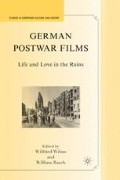Abstract
It is perhaps appropriate that the first German feature film made in the American zone of occupation, Zwischen Gestern und Morgen (1947), was a criminal thriller, a noir of sorts, shot in what remained of Munich’s Regina Palast Hotel. The plot, fragmented through a series of flashbacks, shuttles between the immediate postwar era and the Nazi period as various characters recount the events surrounding the tragic fate of one of the hotel’s late guests, the Jewish stage actress, Nelly Dreyfuss (Sybille Schmitz). In the 1930s, Nelly furtively breaks the Nuremberg laws when she checks into the Regina so that she may experience, one last time, the luxury of her cosmopolitan Weimar life. When the Nazi secret police (“disguised” in trench coats and fedoras) pursue her through the hotel’s dark corridors, Nelly takes her own life by throwing herself from the banister of the interior grand staircase. Now, in 1946, one of her acquaintances, Michael Rott (Viktor de Kowa), has returned to the Regina from his exile in Switzerland. He comes in search of another woman he loved only to find himself accused of having stolen Nelly’s jewels before he himself fled the Nazis. To clear his name, these jewels must be recovered from the rubble that is already in the process of being removed.
Spatial structures are the dreams of a society. Whenever the hieroglyph of any such spatial structure is decoded, the foundation of the social reality is revealed.
—Siegfried Kracauer1
Access this chapter
Tax calculation will be finalised at checkout
Purchases are for personal use only
Preview
Unable to display preview. Download preview PDF.
Notes
Quoted in Thomas Y. Levin, “Introduction” to Siegfried Kracauer, The Mass Ornament: Weimar Essays, trans. Thomas Y. Levin (Cambridge, MA: Harvard University Press, 1995), p.29.
Edward Dimendberg, Film Noir and the Spaces of Modernity (Cambridge, MA: Harvard University Press, 2004), p.64.
This is only a partial list of forbidden themes as stated in U.S. Military Regulation 21–606, 21–606.1. Quoted in Peter Pleyer, Deutscher Nachkriegsfilm, 1946–1948 (Munster: C.J. Fahle Verlag, 1966), p.26.
In 1946 film attendance in western zones of Germany was at 300 million. It rose to 459(6) million in 1947. In 1948, however, after the currency reform, attendance dipped to 443 million. Berkhard Dreher, Filmförderung in der Bundesrepublik Deutschland (Berlin: Duncker & Humblot, 1976), p.66.
Helmut Käutner, “Demontage der Traumfabrik,” in Käutner, ed. Wolfgang Jacobsen and Hans Helmut Prinzler (Berlin: Schulz & Schulz GmbH, 1992), pp.113–114.
Dennis L. Bark and David R. Gress, A History of West Germany: vol. 1, From Shadow to Substance, 1945–1963 (Oxford: Basil Blackwell, 1989), pp.130–131.
Siegfried Kracauer, Theory of Film: The Redemption of Physical Reality (Princeton, NJ: Princeton University Press, 1997), p.55.
Theodor Adorno, Minima Moralia: Reflections on a Damaged Life. trans. E.F.N. Jephcott (London: Verso, 2005), p.39. In a way that speaks to the temporality of Braun’s film, Nico Israel notes that this “enigmatic and hyperbolic” claim Das Haus ist vergangen means both “the house is gone” and “the house is [in the] past.” Outlandish: Writing between Exile and Diaspora (Stanford: Stanford University Press, 2000), p.83.
Georg Lukács, The Theory of the Novel. trans. Anna Bostock (Cambridge, MA: MIT Press, 1971, 1983), p.22. The hotel abyss is the wonderful architectural metaphor Lukács uses to describe the community of German intellectual exiles in the United States who live in a “beautiful hotel, equipped with every comfort, on the edge of an abyss, or nothingness, of absurdity.” This phrase has also come to characterize the spirit of Frankfurt School criticism. Israel, Outlandish, pp.85–86, 200–201; Quote from Adorno, Minima Moralia, p.39.
For a discussion of the anti-American Soviet propaganda in occupied Germany see Norman M. Naimark, The Russians in Germany: A History of the Soviet Zone of Occupation, 1945–1949. (Cambridge, MA: Harvard University Press, 1995), pp.426–427.
For a discussion of Northside’s production history and its use of on-location shooting see Steven N. Lipkin, “Real Emotional Logic: Persuasive Strategies in Docudrama,” Cinema Journal 38.4 (Summer 1999): 68–85.
Gustav Hartlaud, “Introduction to ‘New Objectivity’: German Painting Since Expressionism,” in The Weimar Republic Sourcebook, ed. Anton Kaes, Martin Jay, and Edward Dimendberg (Berkley, CA: University of California Press, 1994), p.491.
Daniel Bluestone, “Preservation and Renewal in Post–World War II Chicago,” Journal of Architectural Education 47.4 (May 1994): 212.
Susan Buck-Morss, The Dialectics of Seeing: Walter Benjamin and the Arcades Project (Cambridge, MA: MIT Press, 1999), p.170.
Editor information
Copyright information
© 2008 Wilfried Wilms and William Rasch
About this chapter
Cite this chapter
Fay, J. (2008). Rubble Noir. In: Wilms, W., Rasch, W. (eds) German Postwar Films. Studies in European Culture and History. Palgrave Macmillan, New York. https://doi.org/10.1057/9780230616974_9
Download citation
DOI: https://doi.org/10.1057/9780230616974_9
Publisher Name: Palgrave Macmillan, New York
Print ISBN: 978-1-349-37504-2
Online ISBN: 978-0-230-61697-4
eBook Packages: Palgrave Literature & Performing Arts CollectionLiterature, Cultural and Media Studies (R0)

